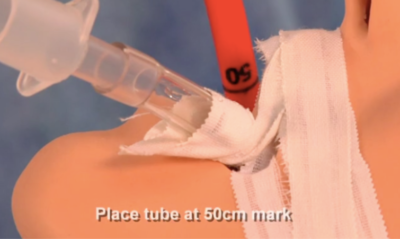Minnesota (Blakemore) Tube Insertion
Gastrointestinal
Context
- This is a measure used pending definitive scope treatment by GI.
Minnesota Kit Overview
Step 1: Intubate
Inubate patient then position the head of the bed at 45°.
Steps 2: Check Balloon
Check balloons for leakage.
- Remove 1 plug each of gastric and esophageal balloon ports with Kelly clamps.

- Connect Christmas Tree Adapter to the gastric balloon port.

- Test by deflating and inflating the balloon with a 60cc syringe in gastric port. Fully deflate when satisfied there are no leaks. Then clamp.


- Repeat with esophageal balloon port. Clamp.

Step 3: Insert
Insert.
- Lubricate balloons.
- Insert through the mouth until tube sits at the 50cm mark.

- Release clamp of gastric balloon. Inflate gastric balloon with 50cc of air. Reclamp.
- Obtain CXR to confirm placement below diaphragm.

- If confirmed to be in stomach: inflate another 200-250cc in gastric ballon (up to 500cc for Minnesota).
- Pull balloon back until it abuts the GE junction.

- Secure with rope: slip knot around tube (or any knot).

- Square knot through saline bag (or any knot).

- Create pulley system by hanging saline bag over IV pole.

- Mark tube at the lips (to monitor in case of balloon migration).

- Connect both aspiration ports to wall suction.

Step 4: For Ongoing Bleeding
If ongoing bleeding: inflate esophageal balloon. (Note: rupture of esophagus due to over-distention is almost always fatal).
- Inflate in 50-60cc aliquots of air (clamp in between while pulling air in syringe).
- Check pressure with sphygmomanometer in between aliquots.
- Pressure should be between 30-45mmHG.
Related Information
OTHER RELEVANT INFORMATION
Relevant Resources
RESOURCE AUTHOR(S)

DISCLAIMER
The purpose of this document is to provide health care professionals with key facts and recommendations for the diagnosis and treatment of patients in the emergency department. This summary was produced by Emergency Care BC (formerly the BC Emergency Medicine Network) and uses the best available knowledge at the time of publication. However, healthcare professionals should continue to use their own judgment and take into consideration context, resources and other relevant factors. Emergency Care BC is not liable for any damages, claims, liabilities, costs or obligations arising from the use of this document including loss or damages arising from any claims made by a third party. Emergency Care BC also assumes no responsibility or liability for changes made to this document without its consent.
Last Updated Oct 17, 2018
Visit our website at https://emergencycarebc.ca
COMMENTS (0)
Add public comment…





POST COMMENT
We welcome your contribution! If you are a member, log in here. If not, you can still submit a comment but we just need some information.